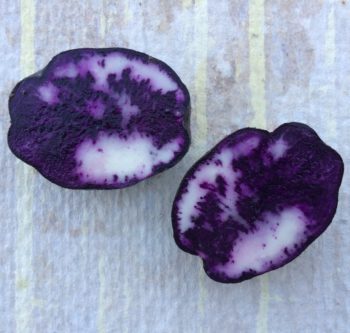No products in the cart.
Blog, potato (Solanum tuberosum)
A Blue Potato by Any Other Name…
Would taste just as sweet? Maybe not. But it probably would taste the same. There are about 30 blue fleshed heirloom potatoes that are common in North America and Europe, but it turns out that they are almost all synonymous. This is a big problem in potatoes and with heirloom vegetables in general. People forget the names of what they are growing or never knew them. Later, they give them a name and a synonym is born. A story gets created to go with the new name, facts usually get distorted or ignored entirely, and pretty soon you have twenty names and stories for the same variety. There are dozens of heirloom potatoes with blue flesh in the USA, but it turns out that most of those are synonyms of just two: All Blue and Purple Peruvian. Those are the most common names used in North America, but they go by different names in Europe. As is often the case, I am writing this post as much for my own reference as anyone else’s. So many of these synonyms have been reported in potato pedigrees that it is easy to get confused. I’ll probably update this from time to time as new results are reported. It is important to understand that I am referring to heirlooms in this article – old varieties. There are more blue varieties that are the product of modern breeding, but relatively few old ones.
The All Blue Complex
All Blue is a tetraploid potato variety of unknown origin. It was originally used as a marker potato, to show where similar varieties were separated in the field. It is self compatible, so it could be from Andean background, but I have found no reports of its cytoplasm type, which is the only way to be certain. It has been used often in breeding new varieties, such as Bora Valley and Purple Majesty, and is popular among hobby breeders because it is male fertile and self compatible. This is one of the most frequent sources of surprise berries. It has the largest number of synonyms that I have seen for a potato. Synonyms that have been confirmed by genotyping (Cote 2017) include Blaue Schweden, Blue Salad, British Colombia Blue, Congo (Canada/Sweden), Gfohler Blaue, MacIntosh Black, Nova Scotia Blue, River John Blue, Russian Blue, Salad Blue, Sharon’s Blue, and Shetland Beauty. Other names that are probable synonyms based on morphological characteristics include Black Russian, Blue Congo, Blue Marker, Blue of Sweden, Davis Purple, Eureka Purple, Fenton Blue, Gurney’s Blue, Gurney’s Purple, Himalayan Black, Idaho Blue, Purple Congo, Purple Mountain, and Shaw #7.
The Purple Peruvian Chilean? Complex

Purple Peruvian is also a tetraploid, supposedly of Peruvian origin, but that appears unlikely. It is male sterile and has a form more consistent with Chilean potatoes, including day neutral tuber formation and the characteristic long stolons. Esnault (2013) found that its synonym, Vitelotte Noire, clustered with genetic markers for Chiloe Island landraces, which is pretty clear evidence of a Chilean origin. All signs point to it being a member of the lowland group Chilotanum, not the highland group Andigenum. I guess “Purple Chilean” doesn’t have the same alliterative appeal though. This variety also has plenty of synonyms. Hoekstra (2014) detected several synonyms through genotyping and results for several more were recently reported in the Kenosha Potato Project Facebook group (Spanoghe 2019). Confirmed synonyms include Ajanhuiri, Blue Peter, ECOS Purple, Elmer’s Blue, Oikos Blue, Purple Finger, Sisu Azul, Unbekannte Schwarze, Urenika, Vitelotte, and Vitelotte Noire. To-le-ak/Toleac/Toleak, Purple Congo, and Saphhire have also been suggested as probable synonyms. There is probably no changing it at this point, but Vitelotte Noire seems like a better name for this variety, since it is not misleading and is also longer standing, having been grown under that name in France since the early 1800s.
To confuse the matter further, some of these names are homonyms. For example, there is a Congo sampled from Canada that is a synonym of All Blue, but also a Congo sampled from the UK that is a synonym of Purple Peruvian. The results of genotyping are only as good as the ID of the varieties studied.
Some people who have grown synonymous varieties think that they are morphologically different. This is certainly possible. Genetic markers are able to detect major rearrangements of the genome that occur as the result of sexual recombination, but they will not necessarily detect somatic mutations. Somatic mutations are fairly common in potato and can accumulate over time, resulting in lines of clones that are indistinguishable by genetic markers but with some differences in traits. In many cases, synonyms have been geographically separated for a long time, with populations in North America, South America, and Europe. It is likely that there has been at least a little divergence. Another possible reason for differences is disease burden. Potatoes tend to perform differently and display different morphological characteristics when infected with viruses. Many of the synonymous varieties have been maintained as heirlooms and are not available as certified tubers, so they may have greater disease burdens compared to the commercially available forms.
